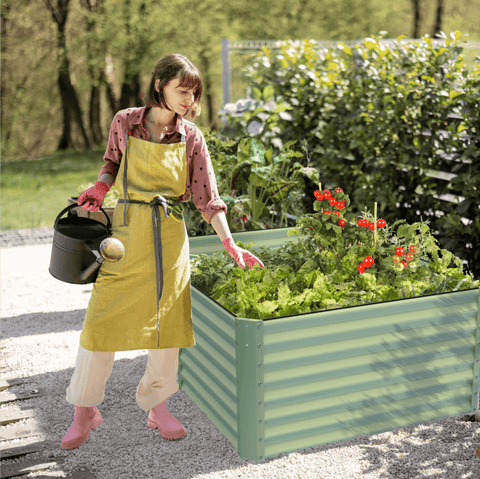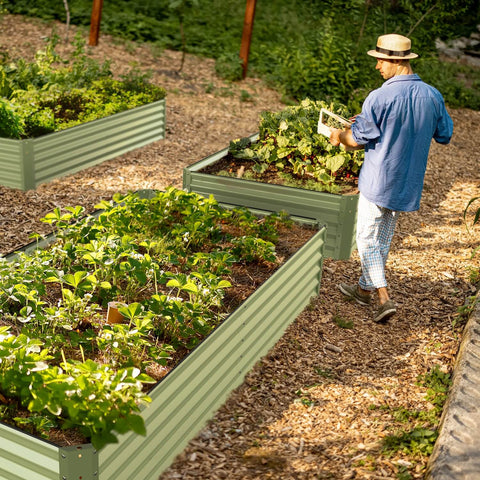Tomato farming is notoriously a bit fussy, and it seems a lot can go wrong when it comes to growing tomatoes. But often the cause of a poor harvest or disease is a simple mistake that can be easily avoided. Here are seven of the most common tomato growing mistakes and tips to avoid them this season, which also have some reference value for planting in raised garden beds.
Mistake # 1: Planting tomatoes too early
Gardeners in cold areas often bring out young plants before the last frost of the season. Low temperatures will kill the seedlings in a short time. Even if the seedling is not killed by the night frost, it may be stunted and take several weeks to regain its strength and vitality. Transplant tomato seedlings outdoors at night when temperatures are usually above 50 degrees. Tomatoes grow best when the nighttime temperature is between 60 and 70 degrees Fahrenheit.
Mistake # 2: Start with poor quality seedlings
At a garden center, it's easy to pick the tallest grafts, even if they're lanky or blooming and about to bear fruit. Resist the urge. Bigger doesn't always mean better when it comes to tomato plants. When buying tomato seedlings or growing them yourself, look for firm, firm plants with straight stems and bright green leaves. Tall, slender seedlings and flowering plants usually spend a few weeks longer in the garden than stout seedlings.

Mistake # 3: Shallow planting
Unlike most plants, tomatoes can grow roots along the main stem. Because of this special ability, tomato seedlings can be planted deeper than when they were grown in a nursery. When planting seedlings, the top of the root ball is 2 to 3 inches below soil level. Deep planting will stimulate a larger, more expansive root system if the graft is located at ground level.
Mistake # 4: Watering is erratic
Tomato plants thrive when they receive about 1 inch of water per week. When rainfall does not provide the necessary moisture, it can be replenished by hand watering or with a soaking hose or drip irrigation. Tomatoes are more likely to burst or blossom and rot if moisture fluctuates significantly. For example, too much water during a period of dry conditions can cause the plant to absorb so much water that the flesh expands before the surrounding outer skin expands, causing the tomato to crack. Flower tail rot occurs when soil moisture fails to help plants get the calcium they need for fruit development. Bottom line: Make sure tomato plants receive about 1 inch of water per week.

Mistake # 5: Overhead watering
When watering the tomatoes, don't splash the leaves. Instead, use watering sticks, long-necked watering cans, or soaking hoses to deliver water to the base of the plant. This direct-to-root watering method helps prevent leaf diseases, especially those that splash out of the soil. In addition, it maximizes water delivery to plant roots, reducing water evaporation loss and thus avoiding wasting water in the garden.
Mistake # 6: Planting too close together
Except for shrub or patio types, tomatoes grow best when planted at least 3 feet apart. Having enough space between plants to allow air to circulate is essential for drying leaves quickly after rain or morning dew. Leaves that dry quickly are less likely to be attacked by disease.
Mistake # 7: Planting in the same place year after year
Don't plant tomatoes in the same place every year. Many pests and diseases can live in the soil from year to year, tormenting new crops. Experts recommend a three-year rotation of tomatoes and their close relatives, peppers, potatoes and eggplants. Another good way to limit soil-borne diseases is to remove all tomato plant debris at the end of the season, especially if your tomatoes are infected with disease. Once your plants die, you can reduce the chances of the disease reappearing next season by cleaning them thoroughly.
In conclusion, tomato farming can be a bit tricky, but by avoiding these common mistakes, you can ensure a successful harvest. Remember to plant at the right time, choose healthy seedlings, plant them deep, water consistently, avoid overhead watering, give them enough space, and rotate their location each year. By following these tips, you'll be on your way to growing delicious tomatoes and other crops in your garden or raised bed. Happy planting!









